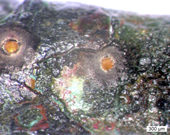Florence Cattin
My doctoral research program (Université de Genève, Switzerland, 2004-2008) focused on copper metallurgy during the final Neolithic, Bell Beaker and Early Bronze Age (2800-1550 BC). A data set of copper and bronze artifacts from Western Switzerland have been studied using metal analysis (lead isotope ratios and chemical composition). The potential provenance of the artifacts was deduced from the analytical results, and then compared to the archaeological context.
Within my post-doctoral research project (Université de Montréal, Canada, 2008-2009), my analytical knowledge was applied to copper trade in Northeastern North America. I tried to determine the importance of the Lake Superior mining district in the copper supply of the Île aux Allumettes and Île Morrison archaeological sites, Ottawa River, Quebec (Late Archaic period).
In 2010, I joined the team led by P. Degryse, within the ERC Research Program ARCHGLASS (Katholieke Universiteit Leuven, Belgium, 2010-2011). I used the chemical composition and Sr/Nd isotopic ratios to study the production and circulation of Roman glass in the Rhine Area.
In 2011, I joined the Laboratory ARTEHIS UMR 6298 (Archaeology, Earth, History, and Societies), at the University of Burgundy in Dijon, France, where I have been working as an assistant professor.
Main projects:
« Le cuivre au Campaniforme : identification des compositions métalliques et interactions en Europe occidentale au 3e millénaire avant notre ère » (Conseil régional de Bourgogne, FABER 2013-9201AAO047S, 2013-2014).
« Activités minières et métallurgiques : Anthropisation des milieux et productions matérielles » (Chaire d’excellence du CNRS, 2011-2016).



(Photo credits: M. Labaune, ARTEHIS; F. Cattin, ARTEHIS; M. Senn, EMPA Dübendorf)